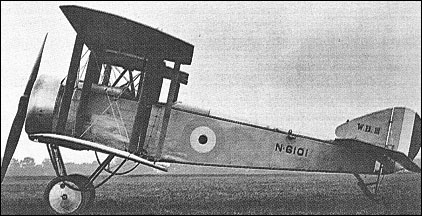|
| The W.B.Ill single-seat shipboard fighter was an extensively
modified variant of the Sopwith Pup with
manually-folding mainplanes and folding main undercarriage
members. The prototype (a modified Pup) was
officially accepted on 7 February 1917, and 100 production
W.B.Ills were ordered under the official designation
S.B.3. Armament comprised a single 7.7mm Lewis gun which fired upwards through a cut-out
in the upper wing centre section, and the W.B.Ill could
be fitted with either the seven-cylinder Clerget or ninecylinder
Le Rhone 9C rotary, both of 80hp. The first 13
production W.B.Ills had folding undercarriages similar
to the prototype and were known as S.B.3Fs, but subsequent
W.B.Ills had jettisonable undercarriages
(S.B.3D) and flotation equipment. The S.B.3D version
saw some service aboard British carriers, one was used
in an unsuccessful attempt to fly from the forecastle of
the battle cruiser HMS Renown and several were supplied
to Japan.
 | A three-view drawing (1278 x 956) |
| WEIGHTS |
| Take-off weight | 585 kg | 1290 lb |
| Empty weight | 404 kg | 891 lb |
| DIMENSIONS |
| Wingspan | 7.62 m | 25 ft 0 in |
| Length | 6.16 m | 20 ft 3 in |
| Height | 2.46 m | 8 ft 1 in |
| Wing area | 22.57 m2 | 242.94 sq ft |
| PERFORMANCE |
| Max. speed | 166 km/h | 103 mph |
| Charles E. Mac Kay, e-mail, 20.09.2011 00:24 The letter S stands for Sopwith B stands for Beardmore, they were all WBIII /S.B.F F for folding. The Lewis on the upper wing was horizontal and did not fire through the upper wing gap. The last thirty were delivered as spares. It could never get over 80 mph. reply |
|
Do you have any comments?
|
| 
COMPANY
PROFILE
All the World's Rotorcraft
|







